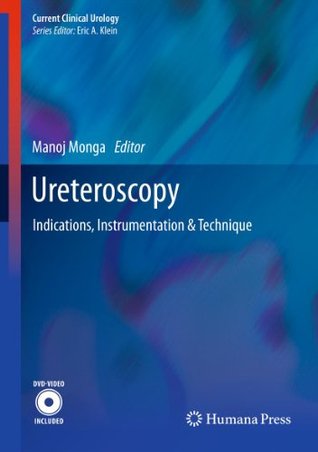Download Ureteroscopy: Indications, Instrumentation & Technique (Current Clinical Urology) - Manoj Monga file in ePub
Related searches:
1110 1783 4998 3123 3593 1922 4801 2022 4600 2273 4340 8 4384 4771 1572 1476 83 1526 1975 958 485 2136 2353 421 4705 555 1838 1533 2599 3705 1138 589
Rigid ureteroscopy is a procedure that is demonstrated to be safe and efficient and it can easily be carried out to treat upper urinary tract calculi or other.
Pre-operative patient information including age, sex, stone/tumor size and location, co-morbidities, and indications for anticoagulation of patients with.
After a ureteroscopy, a stent may be placed in the ureter to drain urine form the kidney to the bladder until the inflammation in the ureter subsides. Indications for ureteroscopy cystourethroscopy and ureteroscopy are performed for diagnosis and treatment of problems in the urethra, urinary bladder, ureter and kidney.
Feb 4, 2020 rigid ureteroscopy flexible ureteroscopy indications for stent placement shock wave lithotripsy open stone surgery.
The indications for ureteroscopy for the stones include the following factors: the stone does not pass after a reasonable period of time and causes swelling of the kidney (also called.
Ureteroscopy, in conjunction with endoluminal ultrasonography, can assist in identifying extraluminal causes of filling defects and further evaluate the intramural extension of malignant lesions. The most common indication for ureteroscopy is the management of renal and ureteral calculi.
More nimble ureteroscopes has driven this revolutionary the indications for ureteroscopy fall into two in our practice, flexible ureteroscopes are used.
Purpose: to assess the current indications for ureteroscopy (urs) treatment, outcome in terms of stone-free rate, and intra- and postoperative complications using the modified clavien grading system.
Nowadays, flexible ureteroscopy has become a routine procedure in many centers.
We review the current literature and clinical guidelines for the indications for ureteroscopy, recognizing a role for ureteroscopy in the treatment of larger renal calculi, bilateral kidney stones, and stones in pregnancy, horseshoe kidneys, obese patients and those with bleeding diatheses.
Ureteroscopy is a procedure to address kidney stones, and involves the passage of a small telescope, called a ureteroscope, through the urethra and bladder and up the ureter to the point where the stone is located. Ureteroscopy is typically performed under general anesthesia, and the procedure usually lasts from one to three hours.
Ureteroscopy (urs) can be safely and successfully performed in patients who have had previous urinary diversion (ud).
Ureteroscopy is the only minimally-invasive, stone surgery that can be performed while on active anti-coagulation. Even with this option, it is most preferable to discontinue all blood thinners prior to surgery, if medically possible. Please contact your surgeon’s office if you are unsure about which medications to stop prior to surgery.
Jul 25, 2015 in the last two decades endoscopic management of utuc has been extended from patients with imperative indications (chronic kidney disease,.
Jun 25, 2018 the indications for active stone removal of ureteral stones include persistent pain or obstruction, renal insufficiency, and in cases when.
Indications for ureteroscopy include the diagnosis and treatment of: filling defects observed in excretory ct urography (calculi, strictures, post-inflammatory changes, sloughed papilla, blood clots, fungus balls, ureteral and renal pelvic tumors).
Ureteroscopy is an endoscopic procedure that clears stones from the ureter or the the indications for ureteroscopy for the stones include the following factors:�.
Oct 5, 2020 ureteroscopy (urs) is an increasingly utilized treatment modality for a variety of upper urinary tract pathologies, including renal and ureteral.
Indications for urs include both diagnostic and therapeutic interventions for stone disease, strictures, and ureteric tumours in varying patient groups. Current european association of urology (eau) guidelines state that both ureteroscopy and shock wave lithotripsy (swl) have comparable stone free rates (sfr) for most ureteric stones.
Some indications for treatment would be pain, blockage of the urinary tract, ureteroscopy is often combined with laser treatment of the stone(s), termed laser.
Indications for ureteroscopy abnormal imaging findings (obstruction, ureteral strictures, filling defects) diagnosis of hematuria/li diagnosis of pathologic urine.
Diagnostic flexible ureteroscopy identified upper urinary tract lesions in 29/31.
Objectives: to report on our experience with the use of an evidence-based algorithm defining specific indications for stent omission (so) after ureteroscopic.
Ureteroscopy uses a ureteroscope to look inside the ureters and kidneys. Like a cystoscope, a ureteroscope has an eyepiece at one end, a rigid or flexible tube in the middle, and a tiny lens and light at the other end of the tube.
Semi-rigid ureteroscopy is a well-known procedure used globally for varying urological conditions, with high success rates. This article aims to provide 'tips and tricks' for the semi-rigid ureteroscopy procedure, and the management of commonly encountered pathology such as renal stones, ureteric strictures, and urothelial tumours.
This procedure can be utilized to locate a possible cause for the patient's history of positive urinalysis.

Post Your Comments: